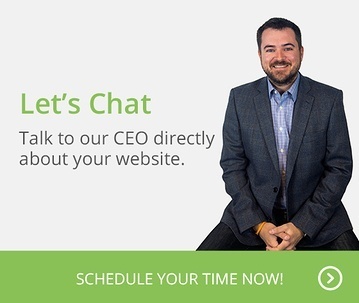As if web design and development wasn't complicated enough, seemingly small omissions early in the process can lead to big problems long after a project is complete. Take admin-level permissions as an example.
You might not even think about this sort of thing as you begin your design process. You’re preoccupied with how everything is going to look, so how things work is likely not at the top of your list of things to worry about. But inevitably, as soon as more than one person begins to work on and update your site, you could run into serious issues that need to be resolved.
But don't despair: Many of these large problems, determined to pop up after the completion of your project, can be avoided simply by addressing them early and thoroughly. Determining admin-level permissions for your website before you begin the design process, for example, comes with a variety of undeniable benefits.
Why Admin-Level Permissions Matter
Depending on the size of your business, you might not be the only person responsible for updating and maintaining your website. This is true even if you were the sole person to manage the design and build process. Multiple members of your organization may write blog posts, or update and maintain their 'own' pages within the site. This is especially true for decentralized business models like franchises, who will likely take on entire sections of your website or satellite versions thereof to maintain and edit.
This is where you should consider implementing various administrator permission levels within your site's back-end. Not doing so means that every administrator can change any aspect of the site, which can come with potentially serious consequences:
- Inconsistent Content
If you consider your website the center of your digital presence, you naturally want it to present your business and brand well. Inconsistencies throughout your website do the exact opposite. If you simply give every administrator on the site full access to add their personal touch to whatever pages willy-nilly, you will have no way to ensure consistency and avoid cognitive dissonance among your audience.
- No Quality Control
Closely related to the inconsistency issue, the content on your website may also vary wildly in terms of its quality. In the worst cases, you may have pixelated images or badly written content pop up on pages that your audience visits frequently, further impacting your brand negatively.
- Breaching the Boundaries
This is perhaps the direst pitfall of giving full access to every user. Chances are, other than a single webmaster (or a team of webmasters), every administrator will only have a stake in one very specific portion of your site. But if they have full access to edit its entirety, they will inevitably begin to make changes outside their area, breaching the boundaries of their responsibility.
- Lack of Responsibility
When something bad happens to the site, whether it is merely bad content or a breach of boundaries, it will be difficult to understand who was responsible for the error. That, in turn, leads to an inability to adjust for the future and ensure the same error doesn't happen again.
- The Spread of Access
Administrators who need an update done but don't have the time are prone to share their logins with co-workers who can make the edits. This practice is almost impossible to reign in, but far less damaging if the shared access is only to a defined page or group of pages pertaining to a particular area of the website. The spread of access is inevitable, but a controlled spread is much better than the alternative.
In other words, unconstrained access to editing your site can have damaging and potentially dangerous consequences. Controlled admin-level access, on the other hand, can help your website stay consistent, remaining a high-quality representation of your brand.
When to Plan and Implement Admin Levels
Depending on your solution, the specific time in which you can and should implement these varying levels of access may differ slightly. But generally speaking, a "the earlier, the better" philosophy is crucial in making sure that it does not turn from a simple part of your web development process to a major headache.
Planning out your administrator levels and permissions before you begin the development process (i.e. through a discovery process) comes with a number of advantages.
First, you can determine exactly who should have access to what, allowing them input into the initial design of their section. This input, in turn, will make it easier for everyone to edit the site after its launch, reducing the possibility that an administrator unhappy with their section begins making major edits in an effort to “optimize” their pages.
Even more importantly, determining your admin permission levels early on can inform every stage of the development process. It enables you to plan out the navigational/sitemap structure according to editing responsibilities, keep individual administrators up-to-date about the process, and involve them in the testing process.
Knowing your permission level needs can even influence your choice of a CMS, which all come with varying solutions to this issue:
Examples in the CMS Development World
Realizing the importance of varying web admin levels, many CMS providers have integrated these levels into their solutions:
- Wix offers the simplest approach, distinguishing merely between site owners (will full access) and site contributors (whose content needs approved before publishing).
- WordPress allows you to assign user roles in a hierarchical structure, which allows the highest tier to approve all content coming through the pipeline.
- Squarespace takes a similar approach to WordPress, but adds additional roles such as billing, reporting, and comment moderating.
- Drupal takes a more granular approach in which you can assign both hierarchical roles and areas of responsibilities to individual administrators.
- Ektron is similar to Drupal, offering a range of user roles that vary in both responsibility and hierarchical importance.
What's Best For You?
Ultimately, all of the above examples come with a major downfall. As template-based solutions, they do offer ways to restrict access to your site’s back-end, but they don't (perhaps with the exception of Drupal) give you full control over just how that access should be tiered and restricted. That's why to fully enjoy the benefits of admin-level permissions, you might want to consider a custom CMS.
Think about it: You may want to establish a website on which some of your administrators only have access to edit a single page. Setting that up in template-based CMS solutions like Wix, WordPress, and Squarespace is impossible, and even more involved solutions like Drupal and Ektron make that process difficult.
A custom CMS solution, on the other hand, allows you to address the issue of administrator access in as much detail as you need, on a tool-by-tool basis. What you get in return is a powerful solution that enables you to assign very specific roles and permissions to your individual administrators, and avoid the pitfalls we outlined toward the beginning of the post.
Custom solutions may seem daunting at first, especially if you're a small business owner just looking to build a simple website. But your business will grow, and as it does, you need to be sure that all of your marketing and branding efforts—including your website—are scalable. A template-based solution may work fine at first, but probably won't be able to handle the increased load (and administrators) that come with a larger operation.
In other words, custom CMS solutions are perfect to handle the important task of determining and implementing various web admin user roles and admin-level permissions.




